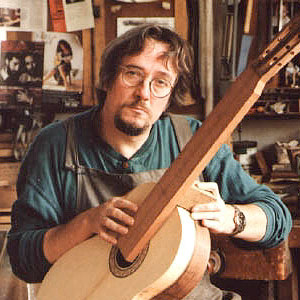| In Memoriam: Thomas Humphrey November 13, 1948 — April 16, 2008 |
|
| Thomas Humphrey, a brilliant designer and maker of classical guitars, recently died of a heart attack at his home in Gardiner, New York. It is a great loss to the guitar community and to those fortunate enough to have witnessed his passion for the instrument and life in general. Among the many things Tom was known for was his millennium design which popularized the elevated fingerboard. He was constantly, fearlessly experimenting with so many aspects of the guitar: soundboard bracing, back bracing, finish, bridge design, and more. His guitars have been used by many fine guitarists, including Sergio and Odair Assad, Eliot Fisk, Ben Verderey, David Tannenbaum, Lili Ashfar, Bruce and Adam Holzman, Sharon Isbin, and many others. His guitars are known for their power, projection, upper treble response, and easy access to the upper register. Early in my own career I had the great fortune and pleasure of meeting Tom at a guitar festival in Boston. I asked him to critique my sixth guitar, which was based on a Torres design with seven fans and a perimeter mosaic. He played several notes, with good rest stroke technique, producing a very nice tone and said, “Listen, it's beautiful. You should visit my workshop.” At his shop I couldn’t help bombarding him with questions about the voicing of instruments, how he got such strong treble response, and such. To my questions he would often respond mysteriously with answers such as “you already know the answer.” When I brought up asymmetrical bracing as a way to push treble response he said, “It’s a myth.” He had experimented with diagonal harmonic bars in the '80s, like so many builders such as Santos Hernandez, Fleta, and Rodriguez to name a few, but later in his career he was using symmetrical patterns exclusively. One time he intensely exclaimed, with fire in his eyes, “Stephan, you must concern yourself with the atmosphere!” As we all know humidity control is so important to the building process for controlling moisture content of parts, doming of plates, and so on, but he was also stressing the importance of having consistent guitars, not summer guitars built at a higher humidity and winter guitars built drier. He was recommending achieving a consistent sound. His guitars hold up remarkably well though rigorous touring, especially considering his thin tops — 2MM was thick for him. He had an expensive automatic humidity-regulation system in his workshop in Gardiner. I’m not entirely sure, but I believe he kept it around 40%. I recently examined a guitar he built in 1985 that had a four-piece top salvaged from a vintage piano soundboard. The guitar’s bridge had been stained, perhaps with coffee, but it appeared to be mahogany. Ideas like these are indicative of his style — always exploring. His later Millenium guitars used the same plantilla as his early ones but were braced with a sort of hybrid X/lattice top with a thin layer of carbon fiber over the X. Over the years Tom offered me advice and guidance in countless ways. It was always offered freely, with only the love of the instrument in mind. What I will miss most about Tom are the intense phone conversations we would have, throwing around ideas at a mile a minute. He was so passionate about guitar making, more than anyone else that I’ve met. The conversations were like roller coaster rides covering so many important topics of lutherie from improving durability of French polish, to what to listen for while evaluating the sound of a guitar, to shaping braces, and methods for building more efficiently. Tom’s spirit and passion will live on in many ways and in many places. I will honor his memory by continuing to build with passion, the best instruments that I can, and recognize the many contributions Tom has made to the evolution of this magical instrument that captivates us all. — Stephan Connor |
Top of Page |

